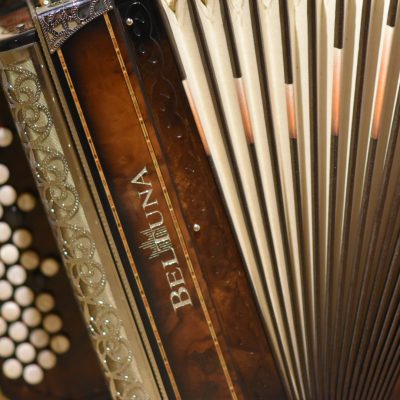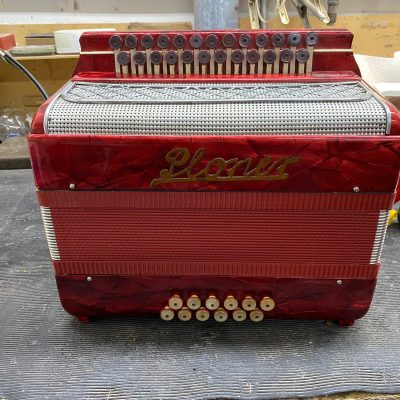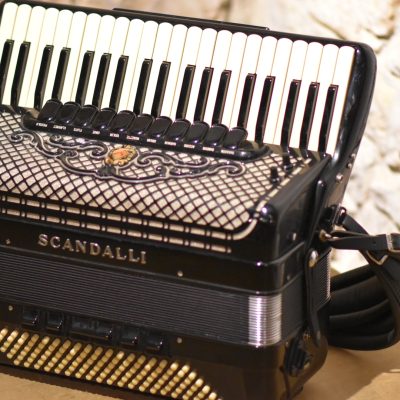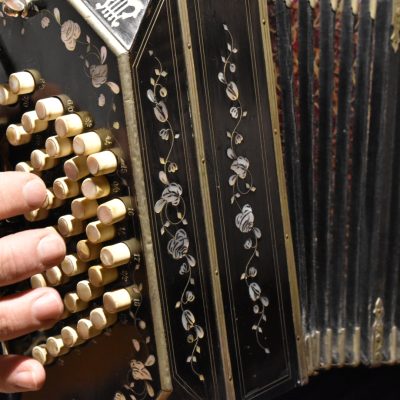ACCORDIONS

Bayan
Read more
The bayan is a chromatic accordion of Russian origin, developed in the early 20th century. Compared to the Western accordion, it is distinguished by its deeper and more powerful sound. Widely used in Russian folk and traditional music, the bayan has also found its place in classical and contemporary music. It is a highly versatile instrument, capable of expressing both delicate melodies and energetic rhythms. Today, the bayan is an iconic instrument in Russian musical tradition and in various international concert settings.

Diatonična
Read more
The diatonic accordion originates from an older accordion invented in Berlin in 1822 and developed in Austria in 1829. It spread mainly in the Alpine countries between Bavaria, South Tyrol, Austria, the Czech Republic and Slovenia. It is characterized by the fact that each key produces two tones when the bellows are pressed or pulled. Chromatic and piano accordions later developed from this type of accordion. The diatonic accordion is a folk instrument, but manufacturers and especially reputable performers have perfected it so much in recent decades that we can play much more than just folk, national “tunes”. Some of them have taken this instrument alongside classical instruments.

Trieštinka
Read more
The Trieste accordion is a variation of the diatonic accordion. The story of this musical instrument begins in Trieste in 1862, when the Ploner family produced the first examples with a completely unique tone arrangement. This instrument immediately became popular with people from Dalmatia to Istria, from Kvarner to Karst, from Trieste to Veneto and many more. It was a constant companion at various holidays, weddings, birthdays, etc. It cheered people up and during the war it alleviated the suffering of soldiers. There are many stories about it. It is a shame that playing this accordion has almost died out. Until the second half of the last century, we still met musicians in Trieste, but then less and less. With the quartet, we also set ourselves the task of reviving and preserving the tradition of this beautiful musical instrument.

Scandalli Super VI
Read more
Scandalli Super VI (and the variant Settimio Soprani Artist VI) is still today, at little more than 50 years from its first appearance on the market, a cult instrument, especially as for sound and mechanicals quality and the quality of all materials used for its construction Super Vi’s mechanical and ergonomic perfection level is, according to what most people says, unequalled: the right keyboard elasticity, the left mechanical precision, the workmanship of reed blocks and reeds in general, the reeds in chamber’s timbre, the registers sensibility and above all an exceptional phonic balance, have made this concerto-accordion become legendary.

Bandoneon
Read more
The bandoneón is a free-reed wind instrument from the accordion family, originally from Germany but which became a symbol of Argentine tango. With its melancholic and deep sound, it conveys intense emotions, making it a central instrument in the music of the Río de la Plata.
Bandoneons can be either chromatic or diatonic. Chromatic bandoneons produce the same note when the bellows are opened or closed; they were the first to be manufactured and continued to be used in Europe. In diatonic bandoneons, one note is produced when opening the bellows and a different one when closing, allowing for dissonances or harmonies. Diatonic bandoneons were adopted by tango performers.
The bandoneón arrived in the Río de la Plata region between 1870 and 1880, becoming a permanent feature in tango orchestras at the beginning of the 20th century.
The bandoneón took on a leading role during the Generation of 1910, in the so-called Orquesta Típica Criolla of Vicente Greco. Other key figures in tango included De Leone, Minotto, and Laurenz. Later came Troilo, Scorticasti, Portier, Ríos, and Ahumada. Finally, Piazzolla, Leopoldo Federico, Mederos, and Rovira.
